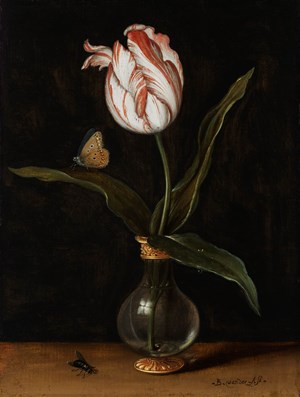
The Mauritshuis has acquired a new flower still life by Balthasar van der Ast. Vase with a Single Tulip from c. 1625 is a rare painting (26.5 x 20 cm) showing only one flowering tulip. Watercolour drawings with the same scene have been preserved in full, such as in tulip albums for bulb growers. In contrast, only two Dutch paintings with a single tulip are known from the 17th century. In 2022, the panel was part of the exhibition In Full Bloom as a showcase for the tulip theme. With Vase with a Single Tulip, the Mauritshuis can present an even more complete picture of the developments in flower still lifes from the early 17th century onward. The acquisition was made possible thanks to the support of the VriendenLoterij.
The Mauritshuis has acquired a new flower still life by Balthasar van der Ast. Vase with a Single Tulip from c. 1625 is a rare painting (26.5 x 20 cm) showing only one flowering tulip. Watercolour drawings with the same scene have been preserved in full, such as in tulip albums for bulb growers. In contrast, only two Dutch paintings with a single tulip are known from the 17th century. In 2022, the panel was part of the exhibition In Full Bloom as a showcase for the tulip theme. With Vase with a Single Tulip, the Mauritshuis can present an even more complete picture of the developments in flower still lifes from the early 17th century onward. The acquisition was made possible thanks to the support of the VriendenLoterij.
The recent acquisition shows a red and white coloured tulip. In the 17th century, these "broken" tulips with flamed petals were the most popular, the reason why paintings almost never depict plain tulips. The only thing people didn't know then is that the "flames" on the tulip were the result of a viral infection. Because of this, the tulip that came out of the bulb in the Spring, would not always be the same. On one of the leaves of the tulip is a butterfly, a blue, whose inner wings can be clearly seen with all the yellow dots. Next to the vase a fat humbug is painted. Whereas the butterfly can symbolize renewal and reincarnation, the humbug refers to death and decay. Probably a conscious choice by the painter to incorporate two extremes into a small and sympathetic painting. The fly points us to the inevitable withering of the tulip, but the butterfly offers us hope. After all, every year a new flower blooms from the tulip bulb.
Shortly after 1600, flower still lifes emerged as a new genre in Dutch paintings featuring a bouquet of blooming flowers. Rare and exotic species were favourites, such as the tulip. With these, painters created impossible bouquets; in reality, the various flowers could never all bloom at the same time.
The ''Dutch'' tulip
The tulip is known as a truly Dutch flower. But is it really? No, the tulip was a new arrival from Asia, introduced from Constantinople (now Istanbul) shortly before 1600. An important role in the spread of this flower in the Netherlands was played by botanist Carolus Clusius, who came from the Southern Netherlands. He came to Holland in 1593 to establish the first Hortus Botanicus in Leiden. He wrote the first scientific treatise on tulips and provided plant lovers with bulbs and seeds.
Balthasar van der Ast
The painter Balthasar van der Ast (Middelburg, 1593/1594) was raised by his older sister Maria. She was married to flower still life painter Ambrosius Bosschaert the Elder (1573-1621). Bosschaert became Van der Ast's teacher and introduced him to flower still lifes. In 1619, Balthasar van der Ast enrolled as a master painter in the Utrecht St. Luke's Guild. At that time, the city of Utrecht was the center for flower still life art. Roelant Savery - about whom an exhibition will be on display at the Mauritshuis in spring 2024 - also worked here. Savery had a great influence on the development of Van der Ast, who made his use of colour his own. In addition, Balthasar van der Ast had the advantage of being able to study various types of flowers at Savery's home in Utrecht, as this painter owned his own garden with exotic flowers and plants.

ArtDependence Magazine is an international magazine covering all spheres of contemporary art, as well as modern and classical art.
ArtDependence features the latest art news, highlighting interviews with today’s most influential artists, galleries, curators, collectors, fair directors and individuals at the axis of the arts.
The magazine also covers series of articles and reviews on critical art events, new publications and other foremost happenings in the art world.
If you would like to submit events or editorial content to ArtDependence Magazine, please feel free to reach the magazine via the contact page.